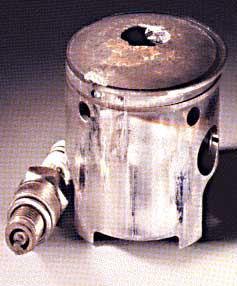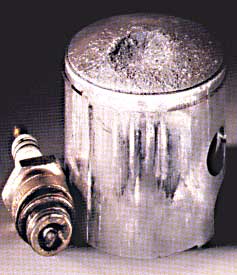|
These pistons are normal in
appearance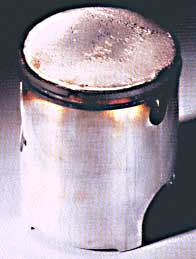
The deposits on the piston
dome are from the oil and ash, fuel contaminants and unburned
carbon. As the thickness increases with operating time, the colour
gets brighter because of higher surface temperatures.
Depending on fuel and oil used, normal deposits may
also be brown, from light tan colour to almost black dark
brown.
Heavy black deposits on the piston dome are unburned
carbon accumulated because of too low temperatures resulting from
light load operation or too rich a mixture.
Brown or black varnish on piston side 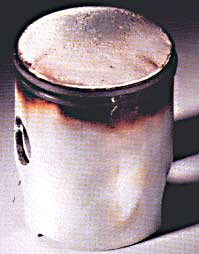 below rings is
baked oil caused by combustion gases blow-by. Improper oil or poor
ring sealing is the cause. below rings is
baked oil caused by combustion gases blow-by. Improper oil or poor
ring sealing is the cause.
Very light scoring of the piston skirt is likely
from foreign material passing through the engine. It does not
suggest a problem in the engine and piston replacement is not
required.
Always check piston to cylinder wall clearance to
make certain the wear limit has not been exceeded.
Deposits should be removed from the piston dome and
cylinder head using a wood or plastic scraper. Excessive deposits
collection will increase the compression ration and reduce heat
transfer. |
|
Seized Pistons
The piston shows yellow spots on the dome and
seizure marks on the skirt but there is no sign of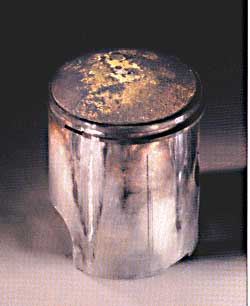 metal aluminium. metal aluminium.
If you inspect an engine and find yellow or
yellow-orange deposits on the piston dome, that engine has
experienced an abnormal combustion condition known as detonation. In
this situation, combustion begins normally with ignition from the
spark plug but as the flame front moves across the combustion
chamber, rather than burning smoothly, the unburned portion of the
charge spontaneously ignites. This results in extremely high
temperatures and a shock wave heard as "pinging." What has happened
is combustion has been completed in about 29 degrees or crankshaft
rotation instead of the normal 50.
The oxide of calcium, an element found in 2 - stroke
oil additives, is normally near white in colour. At temperature very
near that of the melting point of the piston, the oxide will change
colour from white to yellow-orange and is an indicator that the
engine was overheated. The excessive heat results in rapid piston
expansion and possible failure of the lubrication film.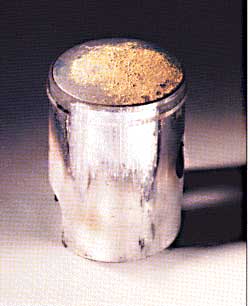
Possible causes:
too low an octane fuel used or fuel with too
much alcohol used
jetting too lean or failure of the fuel system,
i.e., clogged fuel line or filter, fuel tank not venting,
problem with fuel pump, carburettor air leak into
crankcase
spark plug heat range too hot
ignition timing too far advanced, possible
failure of the c.d.i. amplifier box
restricted exhaust system: back pressure too
high
overheated, loosely-installed spark
plug |
|
Piston dome
damage
The piston shows melted areas on the dome and seizure
marks on the skirt.
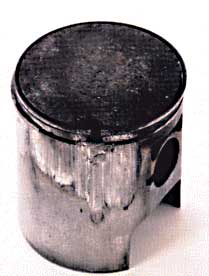
Detonation results in extremely high
combustion chamber temperatures. That rapid heat rise, if allowed to
continue, will heat combustion chamber deposits and spark plug
electrodes to the point that they will ignite the charge before the
spark at the plug does.
This condition is called runaway surface ignition or
pre-ignition. Once pre-ignition occurs, the temperature rise is so
rapid that melting point of the piston is reached while the engine
is still running. Metal will melt away beneath the spark plug or in
areas of high heat retention such as at the ring positioning
pin.
A complete breakdown of the lubrication film also occurs
resulting in severe seizure. Detonation always precedes pre-ignition
and the causes for this abnormal combustion are the same as those
for detonation.
|
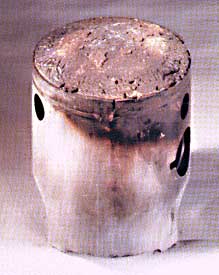 Piston damage by foreign
material
Piston shows imprints of small cylindrical parts on the
dome
Possible Cause
needles of broken wrist pin bearing trapped in
the squish area between the piston and head, destroy the dome,
ring land and rings.
make certain to check the condition of the big
end rod bearing and cage
|
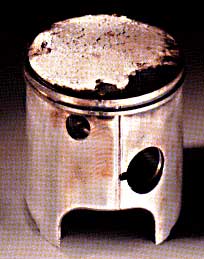 Piston damage by foreign
material
Small ball shaped imprints on piston
dome
Possible Cause
foreign material, e.g. a pop rivet head, has
entered the engine and was trapped in the squish area, before
leaving through the exhaust port. In some cases the engine
continues to run normally until the ring
fails
|
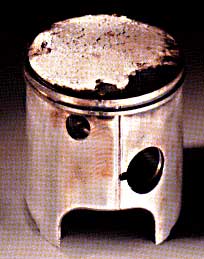 Piston damage by foreign
material
Piston shows a vertical groove on the skirt
connected to the wrist pin hole.
Possible cause:
A wrist pin circlip has come loose and was
trapped in the transfer port window.
Note always use NEW circlips when
rebuilding an ultralight aircraft
engine.
|
Piston with lubrication
failure
(no signs of
detonation on dome)
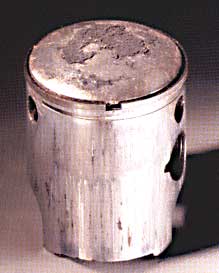 Piston shows scoring marks below the rings on the
intake side.
Possible Cause
Snow or water has entered the engine and
destroyed the oil film
if the piston has scoring on the intake and
exhaust sides but the dome shows no signs of abnormal
combustion, the engine has been run with too little or no oil.
Check the operation of the oil injection system or the amount of
oil in the premixed fuel. Also, insure proper piston
clearance.
if the piston has scoring on the intake and
exhaust sides, no signs of abnormal combustion on the dome and
is very dark in colour, there has been a failure of the cooling
system. Check the fan belt, or coolant level
etc.
|
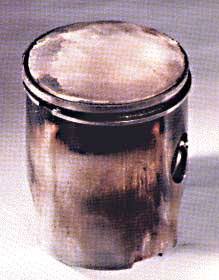 Piston with lubrication
failure
Piston shows dark brown deposits all over the
skirt.
Possible Cause
wrong oil quality, e.g. gear oil, automotive
oil
unnecessary additives have been used in the
fuel, i.e. octane boosters, high performance additives, upper
cylinder lubricants, etc.
|
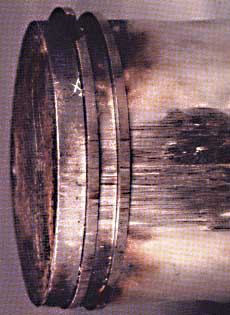 Piston with lubrication
failure
Piston shows scuffing marks on the exhaust side of
the skirt without corresponding marks on the intake side. The
lubrication film failed under thermal load on the exhaust side of
the piston
Possible cause:
Poor quality of
oil.
|
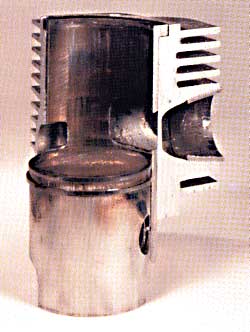 Piston ring
scuffing
Cylinder liner shows
scoring areas, which are exactly limited to the ring travel zone.
Beside the blue coloured vertical stripes, the surface is in good
condition. The rings show corresponding dark coloured marks. The
reason is a breakdown of the lubrication.
Possible Cause
improper break in period
poor oil quality
not enough oil in premixed fuel
low delivery rate from oil injection
system
|
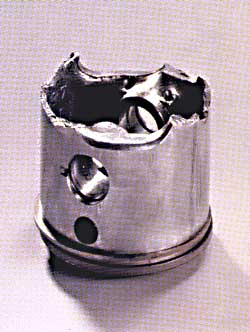 Piston
fracture
Material fatigue fracture can sometimes be observed
on pistons of high speed engines, however, skirt fracture is usually
the result of excessive piston to cylinder wall clearance.
Other possible causes:
connecting rod breakage
damage due to bad handling,
crankshaft locking via piston
blocking
engine has ingested foreign
material
|
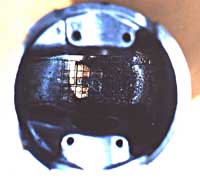 Underside Black Spot
The underside of
this piston has a black spot. The black spot is a carbon deposit
that resulted from pre-mix oil burning on to the piston because the
piston's crown was too hot. The main reasons for this problem are
overheating due to too lean carburettor jetting or coolant system
failure.
|
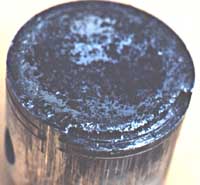 Chipped Crown
Drowned
This piston crown chipped at the top ring groove
because of a head gasket leak. The coolant is drawn into the
combustion chamber on the down-stroke of the piston. When the
coolant hits the piston crown it makes the aluminium brittle and it
eventually cracks. In extreme cases the head gasket leak can cause
erosion at the top edge of the cylinder and the corresponding area
of the head. Minor leaks of the gasket or o-ring appear as black
spots across the gasket surface. An engine that suffers from coolant
being pressurized and forced out of the radiator cap's vent tube, is
a strong indication of a head gasket leak. In most cases the top of
the cylinder and the face of the cylinder head must be resurfaced
when a leak occurs. It's important to check for warpage of the head
every time you rebuild the top end.
|
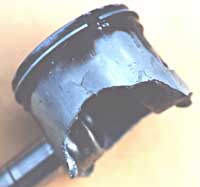 Shattered
Skirt
The skirts of this piston shattered because the
piston to cylinder clearance was too great. When the piston is
allowed to rattle in the cylinder bore, it develops stress cracks
and eventually shatters.
|
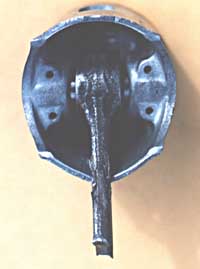 Snapped Connecting
Rod
The connecting rod of this engine snapped in half
because the clearance between the rod and the thrust washers of the
big end was too great. When the big end bearing wears out, the
radial deflection of the rod becomes excessive and the rod suffers
from torsion vibration. This leads to connecting rod breakage and
catastrophic engine damage. The big end clearance should be checked
every time you rebuild the top end. To check the side clearance of
the connecting rod, insert a feeler gauge between the rod and a
thrust washer. Check the maximum wear limits in your engine's
factory service manual
|
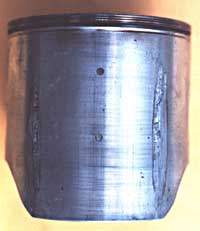 Four-Corner
Seizure
This piston has vertical seizure marks at four
equally spaced points around the circumference. A four-corner
seizure is caused when the piston expands faster than the cylinder
and the clearance between the piston and cylinder is reduced.
Another common problem of this type is a single point seizure on the
centre of the exhaust side of the piston. However this occurs only
on cylinders with bridged exhaust ports. The main causes for this
problem are too quick warm-up, too lean carburettor jetting (main
jet), or too hot of a spark plug range.
|
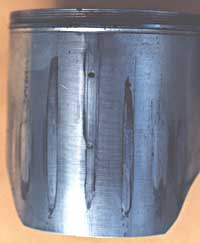 Multi-point Seizure
This
piston has many vertical seizure marks around the circumference.
This cylinder was bored to a diameter that was too small for the
piston. As soon as the engine started and the piston started its
thermal expansion, the piston pressed up against the cylinder walls
and seized. The optimum piston to cylinder wall clearances for
different types of cylinders vary greatly. For example a 50cc
composite plated cylinder can use a piston to cylinder wall
clearance of .0015 inches, whereas a 1200cc steel-sleeved cylinder
snowmobile set-up for grass drags will need between .0055 to .0075
inches. For the best recommendation on the optimum piston to
cylinder clearance for your engine, look to the specs that come
packaged with the piston or consult your Hirth distributor. |
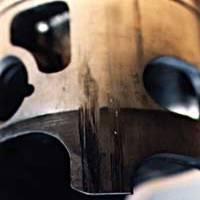 Intake Side
Seizure
This piston was seized on the intake side. This is
very uncommon and is caused by only one thing, loss of lubrication.
There are three possible causes for loss of lubrication, no pre-mix
oil, separation of the fuel and pre-mix oil in the fuel tank, water
passed through the air-filter and washed the oil film off the piston
skirt.
|
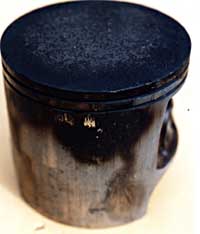 Blow-by
This
piston didn't fail in operation but it does show the most common
problem, blow-by. The rings were worn past the maximum ring end gap
spec, allowing combustion pressure to seep past the rings and down
the piston skirt causing a distinct carbon pattern. Its possible
that the cylinder walls cross-hatched honing pattern is partly to
blame. If the cylinder walls are glazed or worn too far, even new
rings won't seal properly to prevent a blow-by problem.
|



 below rings is
baked oil caused by combustion gases blow-by. Improper oil or poor
ring sealing is the cause.
below rings is
baked oil caused by combustion gases blow-by. Improper oil or poor
ring sealing is the cause. metal aluminium.
metal aluminium.

